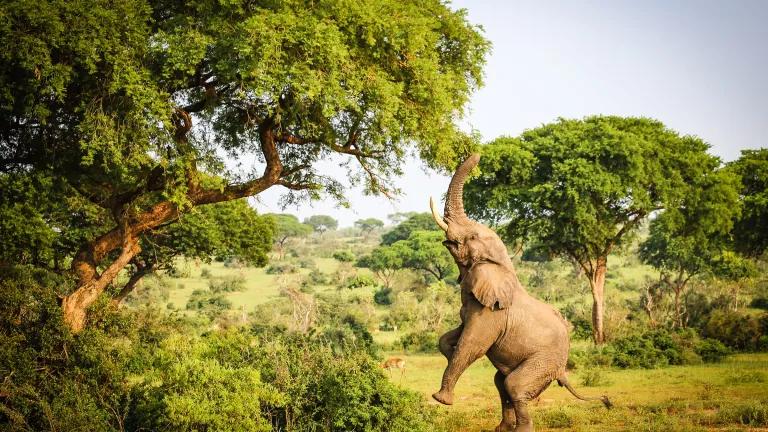
An African elephant grazes on tree leaves in Murchison Falls National Park, in Uganda.
Helen Mason/USAID
Our planet is home to an estimated 8.1 million species of plants and animals, a dizzying total that includes the elephants roaming the Serengeti and the worms in the soil of your local park. Together, with an even greater number of microorganisms, these species define the earth’s ecosystems—and some 80 percent of them have yet to be officially identified.
Protecting this remarkable diversity of life is about more than scientific discovery. Biodiversity remains a primary indicator of our planet’s health and underpins every facet of our society—from our foods and medicines to our cultures to our ability to withstand extreme weather.
But right now, nature is in crisis.
Plant and animal species are disappearing tens to hundreds of times faster than at any time in the last 10 million years, and that pace is accelerating. If we fail to curb threats to nature, from habitat destruction to climate change, scientists warn that one million plant and animal species face extinction—and many within just decades.
“As with so many other issues, we find ourselves on the precipice,” says NRDC wildlife and conservation expert Zak Smith. “But the solutions are also ours for the taking.”
What is biodiversity?
Biodiversity can be defined as the “variety of life in our natural world” and is measured as the number of different species—including plants, animals, fungi, algae, and even microorganisms, like bacteria—that share a certain home region. Biodiversity is a key indicator of the health of an ecosystem. Areas with particularly high levels of biodiversity, like the Northeast Canyons and Seamounts Marine National Monument or the Amazon rainforest, are considered biodiversity hot spots and provide habitat to numerous endemic species, which are species unique to that place.
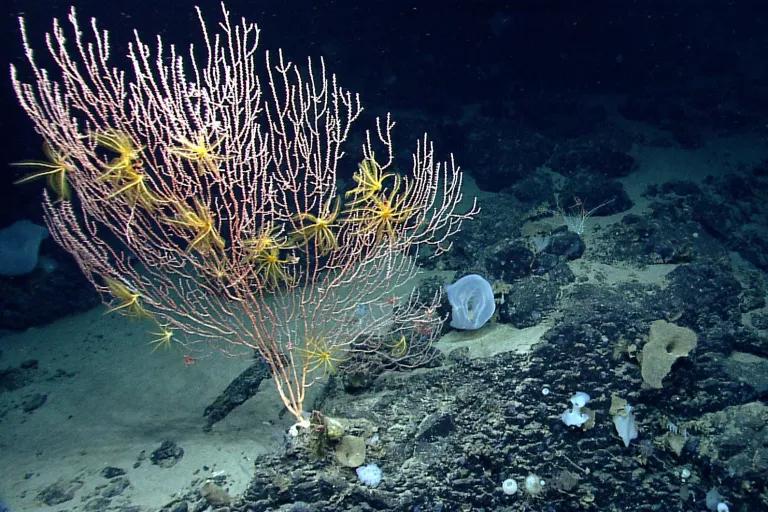
A colony of Jasonisis, a bamboo coral, and crinoids at Mytilus Seamount in Northeast Canyons and Seamounts Marine National Monument
NOAA Okeanos Explorer
Why is biodiversity important?
Thriving biodiversity is necessary for healthy ecosystems, without which we wouldn’t have a secure food supply, clean water, essential medicines, or, ultimately, a habitable climate.
Ecological Importance
At its most essential, biodiversity improves the stability and resilience of an ecosystem. The more complex an ecosystem—the more abundant and variable its life and resources—the more likely it is that some of its species will have the ability to withstand stressors like drought, disease, or a changing climate.
“Say you raze a healthy forest and plant a single monoculture crop in its place,” explains NRDC forest conservation expert Jennifer Skene. “And then you have an infestation break out. That infestation is going to be able to completely devastate the entire field. However, in a diverse ecosystem, some species may be affected—but chances are that some of them will be naturally less vulnerable and survive. That allows for the ecosystem to maintain a foothold and bounce back without total destruction.”
Biodiversity is also critical for maintaining an ecosystem’s web of codependencies. In every ecosystem, species rely on each other, supplying one another with shelter and food, for instance. When species start to disappear—whether it’s apex predators or the fungi that decompose dead material—the system of checks and balances begins to go awry.
Take the example of the sea otter, a keystone species. If sea otter populations decline, populations of one of its primary prey, sea urchins, then explode. Too many urchins can lead the sea kelp grasses, on which the urchins feed, to decline—removing the food and habitat for a number of other species.
“Each player in an ecosystem fulfills its niche,” Skene says. “Once you start losing species that were playing specific ecological roles, the whole thing starts to unravel.”
Ecosystem Services
The concept of ecosystem services, also known as nature’s contributions to people, describes the various benefits that people derive from nature. Biodiverse lands and waters directly and indirectly contribute to our well-being in many ways, including through these essential functions.
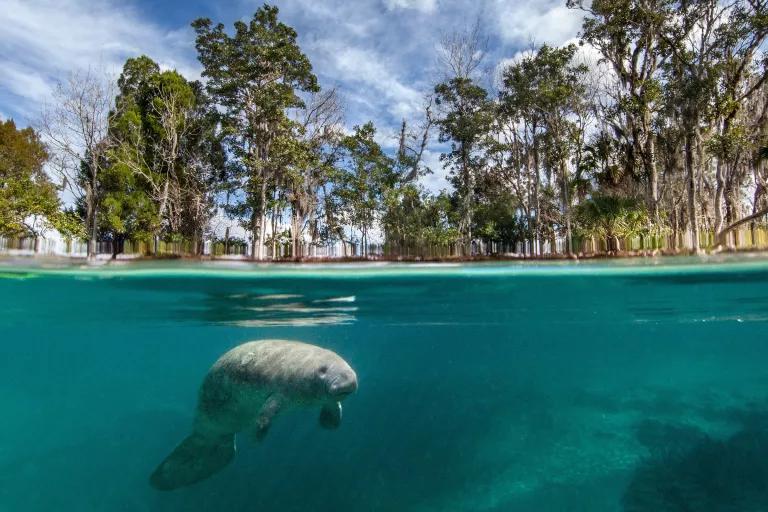
A manatee calf swimming at Three Sisters Springs in the Crystal River National Wildlife Refuge, in Florida. Manatees are dying in record numbers, primarily from starvation, as their main food source of seagrass succumbs to pollution and toxic “red tide” algae blooms.
Ai Angel Gentel/Getty Images
Water filtration
Certain ecosystems have the ability to scrub pollutants out of the environment. Healthy, intact wetlands, for example, sift out sediment, excess nutrients, and harmful chemicals—helping to keep these contaminants out of waterways, drinking water, and the ocean. The value of biodiversity extends to an ecosystem’s smallest members: Bacteria and fungi are adept at decomposing compounds like nitrogen, a common pollutant from agricultural runoff that can lead to aquatic dead zones. One study that looked at how biodiversity serves to buffer natural ecosystems against the impacts of nutrient pollution revealed that streams with a variety of algae species removed nitrogen 4.5 times faster than those with only a single species of algae.
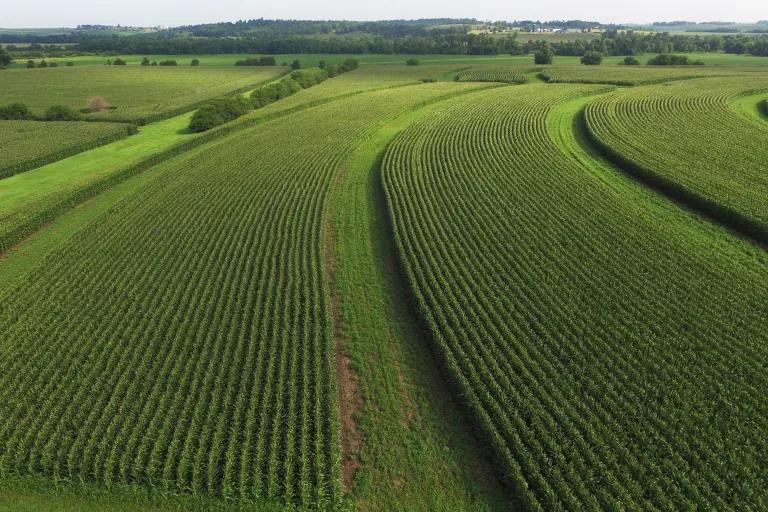
Prairie strips planted on a farm near Traer, Iowa. Prairie strips are a conservation practice that protects soil and water while providing habitat for wildlife.
Lynn Betts/USDA NRCS
Flood protection
Healthy soil that’s rich in bacteria, fungi, and bugs is one of the most cost-effective ways to prevent flood damages and protect ecosystems during drought. In fact, for every 1 percent increase in organic matter in the soil, cropland in the United States could store an additional 45 million gallons of water, or the amount of water that flows over Niagara Falls in 150 days. This natural flood protection is even more important as climate change intensifies rainfall events that inundate our farmland, cities, and towns. In one recent study, scientists found that every dollar invested into floodplain protection saved five dollars in avoided flood damages. “Ecosystem restoration should be a first line of defense against climate-fueled disaster,” says NRDC community-driven conservation expert Amy McNamara.
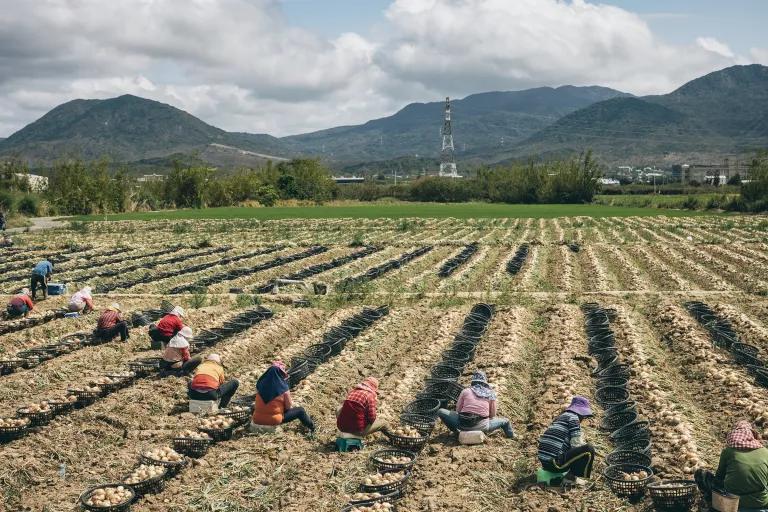
Workers harvesting onions on a farm in Pingtung, Taiwan. According to the U.N. Food and Agriculture Organization, pollinators affect 35 percent of the world's crop production, including onions—but their decline in recent years threatens the stability of a critical ecosystem service.
iStock
Food security
Because of global inequality, many of the world’s eight billion people don’t have adequate food and nutrition. And as climate change worsens the impacts of extreme weather and poverty, more people will struggle to put enough healthy and affordable food on their plates.
“Contrary to the emphasis on monocultures within industrial agriculture, robust biodiversity can help sustain food production and security,” explains Daniel Raichel, NRDC pollinator expert. “For example, one out of every three bites of food relies on pollinators like bees, birds, and bats, whose populations are in steep decline.” And the diversity of plant life above ground improves the diversity of life below ground—in the form of helpful microbes, insects, and fungi in the soil, which in turn boost agricultural output.
But already, losses of biodiversity are exacerbating our food challenges. For example, while fisheries that diversify their catch can more sustainably provide food (and jobs), 20 percent of U.S. fish stocks are currently overexploited. And as of 2019, 23 percent of the world’s agricultural lands were less productive than just five years before, in part due to declines in soil biodiversity and pollinator populations.
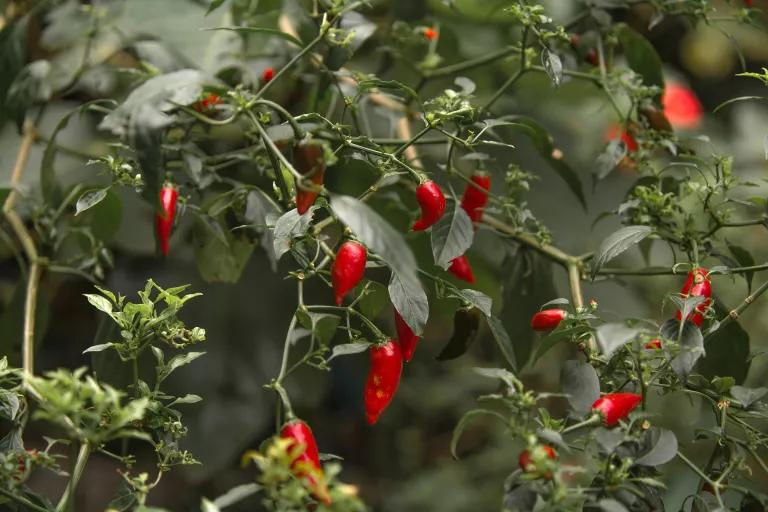
Chili peppers being grown in Curitiba, Brazil
Eduardo Jaeger
Development of medicines
Thousands of important medicines—from penicillin to morphine to aspirin—have been developed from the chemical compounds found in nature. According to the World Health Organization, 11 percent of all the world’s essential medicines are derived from flowering plants and more are developed each year, from anticancer drugs found in Himalayan fungi to pain-relieving compounds derived from chili peppers. As biodiversity is lost, so, too, is the ability to harness nature’s powerful chemical blueprints.
Economic Importance
The value of all the services that healthy ecosystems provide is estimated to be in the hundreds of trillions each year. In turn, the destruction of ecosystems and the loss of biodiversity bring cascading economic costs. That’s why the World Economic Forum listed biodiversity loss as a top economic threat in its Global Risks Report of 2022. One insurance firm, Swiss Re, recently found that while more than half (55 percent) of the global economy is dependent on high-functioning biodiversity and ecosystem services, one-fifth of the world’s countries are at risk of having their ecosystems collapse.
The loss of coral reefs, for example, decimates tourism economies, reduces natural storm surge protection, and means less food and shelter for the fish that many communities depend on for food. And ecosystem destruction that eats away at our natural carbon sinks—like when rainforests or boreal forests are logged—is especially damaging. While the climate crisis represents a nearly incalculable bill, some suggest that it will cost the global economy $23 trillion annually by 2050—a steep price to pay for commodities like the toilet paper made from those old-growth forests.
Social Importance
The influence of biodiversity in society goes deep. Nature guides many of our cultural practices and religious beliefs. It fuels our intellectual and artistic pursuits. It shapes our sense of place. Nature offers us a means of experiencing joy, adventure, and awe. That’s why so many of us are ethically compelled to limit harm to wildlife. We feel a sense of loss as species go extinct.
This is perhaps most true for the Indigenous communities whose traditions and cultures are linked to the health of the environment and who remain at the forefront of the fight to protect it.
In Canada, for example, Indigenous advocates are defending the old-growth boreal forest from unsustainable logging. As Cree elder Allan Saganash Jr. says of his rapidly disappearing home: “My way of life, my culture, my language, and my identity as a Cree person are still very connected to the land. That will always be in our hearts.”
Types of Biodiversity
Biodiversity is measured on a number of different levels, which together contribute to an overall snapshot of the planet’s health.
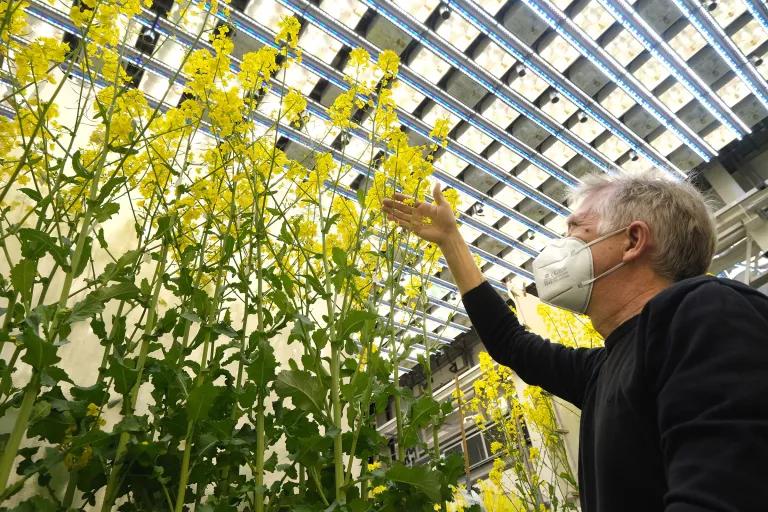
Rapeseed plants grow under lights that imitate the sun at the Leibniz Institute of Plant Genetics and Crop Plant Research in Gatersleben, Germany. The hall enables scientists to grow new plant variants for testing under precise environmental conditions, including those modeled for our warming future.
Sean Gallup/Getty Images
Genetic Diversity
Let’s start with the micro view. Genetic diversity is important within a species. To measure this, scientists can look at how many different versions of a particular gene, an allele, exist within a population. The more variations of that allele—which may determine, say, a plant’s color or its natural resistance to infection—the more genetically diverse that population is and the more likely that population will contain individuals who carry traits that make them resilient to an environmental stressor.
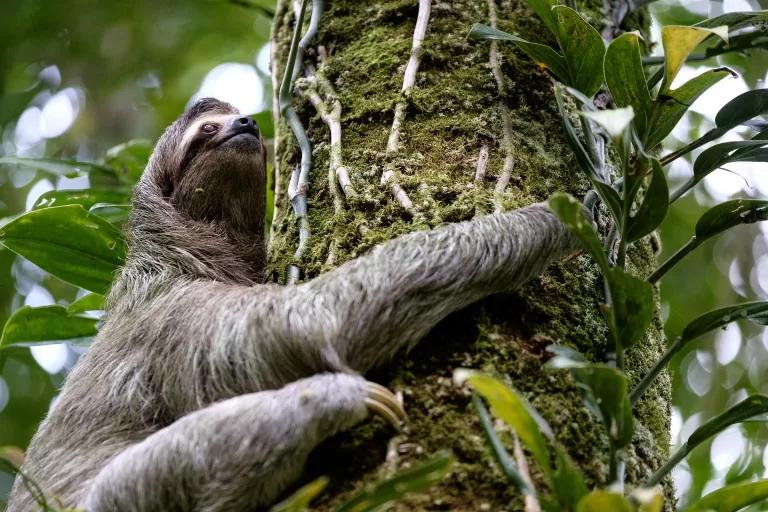
A brown-throated three-toed sloth climbing a tree in Costa Rica
Ben Cherry
Species Diversity
The most common way to view and measure biodiversity is the number of species in a region. Biodiversity spikes near the equator in tropical regions, where a wider variety and concentration of life is found. These areas are often called biodiversity hot spots. However, even the most extreme environments—from the Arctic tundra to the Sahara desert—sustain a diversity of life.
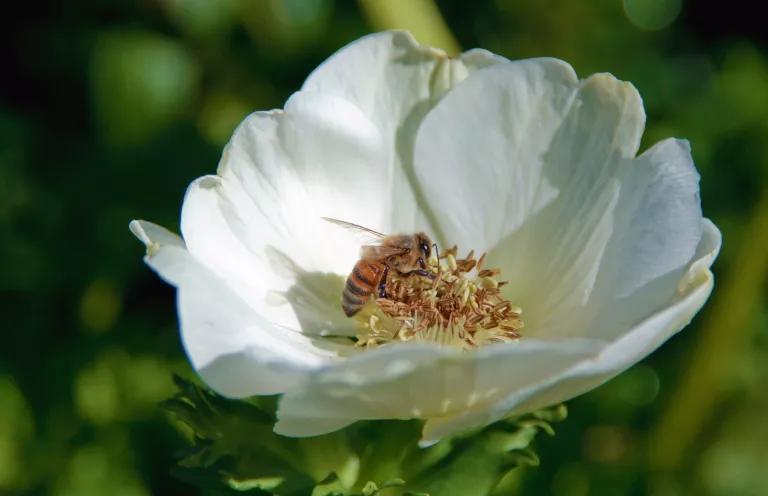
A bee collecting pollen from a flower in Dallas
Jen R via Flickr, CC-BY-NC-ND 4.0
Functional Diversity
Grouping wildlife by the functions they perform—like foraging, nutrient cycling, or predation—is another way to measure biodiversity. Each species fills a niche. When ecosystems are out of balance, it’s often because they’ve lost a species that performed an important function. For example: “Sharp declines in bee populations removes critical pollinators from an ecosystem,” says Raichel. “This negatively impacts vegetation—an ecological crisis that’s currently playing out in real time.”
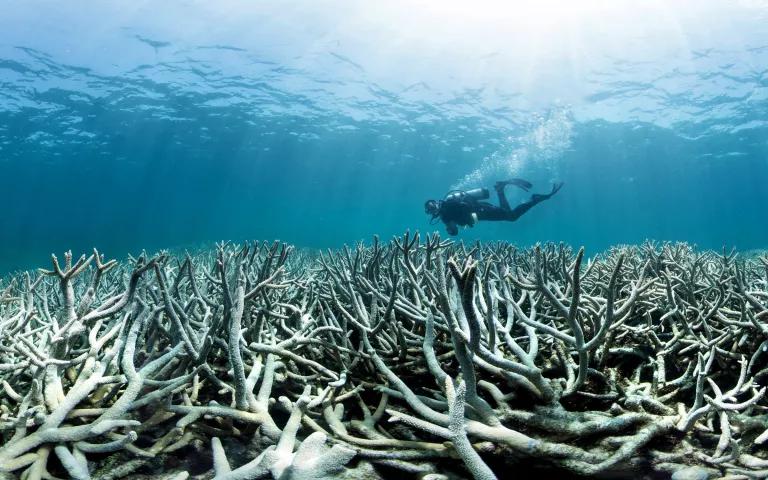
A diver surveys bleached coral at the Great Barrier Reef in Queensland, Australia.
The Ocean Agency/Caitlin Sea Survey, CC BY 4.0
Ecosystem Diversity
In the same way that a diversity of species helps maintain balance within an ecosystem, a diversity of ecosystems maintains balance across the planet. But industrial activities are pushing ecosystems to the brink of collapse. We’ve lost an estimated 85 percent of our wetlands, globally. We’ve seen more than a third of historic forest cover disappear, and half of all coral reefs have died since 1950. Scientists predict that, should we fail to take action, the entire reef ecosystem will become functionally extinct by 2050—with repercussions for all species that rely on them, including us.
Threats to Biodiversity
Much of biodiversity loss can be traced back to human behaviors—specifically industrial activities that worsen inequality and encourage overconsumption. As more species go extinct, it becomes increasingly urgent that we make rapid and systemic shifts that will lessen our environmental impact.
“We need to trash 200-plus years of economic thinking and make way for something better,” says Smith. “For centuries, countries have imposed an unsustainable and destructive economic system on the globe, one that continually reinforces long-held views that the natural world exists to be exploited.”
Habitat Loss
Unsustainable land use changes, like converting a forested area into farmland or mining large swaths of land, remains the single-biggest driver of biodiversity loss. According to the 2019 report from the Intergovernmental Science-Policy Platform on Biodiversity and Ecosystem Services (IPBES), the leading scientific authority on biodiversity, three-quarters of land-based environments and two-thirds of marine environments have already been significantly altered by humans.
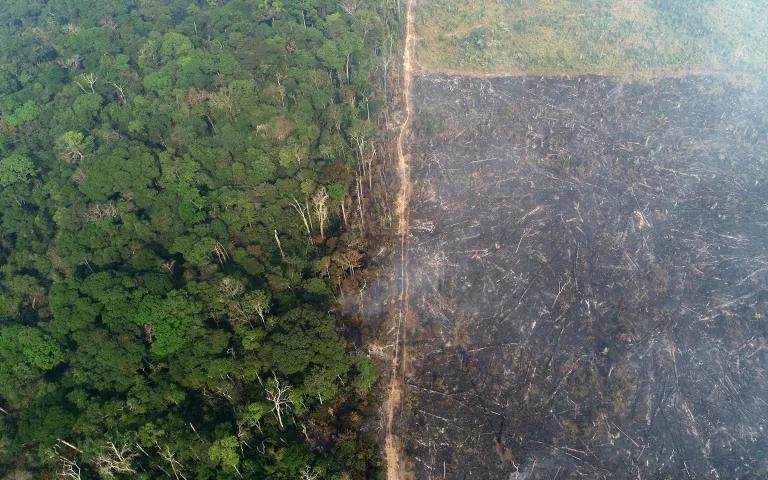
A tract of the Amazon rainforest burned by loggers and farmers near Apuí in the Amazonas State of Brazil
Ueslei Marcelino/Reuters
Our agricultural practices place an enormous burden on the planet. More than a third of the earth’s total land surface and nearly three-quarters of its freshwater resources now go toward crop or livestock production. Other activities that have led to significant habitat loss and pollution include logging, fossil fuel extraction, mining, and industrial fishing. The more we fragment and divide habitat—like when land is urbanized or suburbanized—the harder it becomes for native wildlife to find food and mates, to migrate, and to carry out their natural life cycles.
Wildlife Trafficking and Trade
The rampant trade of plants and animals, both legal and illegal, remains the second-biggest threat to biodiversity. Legal wildlife trade of mammals, birds, and amphibians is helping drive thousands of species to extinction, and illegal trade is also big business. For instance, overharvesting of fish is a leading threat to the stability of marine ecosystems, with a third of fish stocks harvested at unsustainable levels and 60 percent harvested at the edge of sustainability. Meanwhile, the U.S. Department of State estimates that illegal wildlife trafficking is the third-largest type of illegal trade, behind only drugs and weapons, with $10 billion worth of animals, plants, and their parts smuggled each year: Rhino horns may be sold for their purported medicinal value. Squirrel monkeys as exotic pets. Crocodile skin for leather goods. And still other species, like pangolins or sharks, are eaten as delicacies. As these species disappear from their natural environments, the impacts ripple across to other species in their complex ecological webs. The vaquita porpoise is just one example of a species caught in the crossfire: Nets set to illegally catch totoaba fish to fill demand for their swim bladders, considered a delicacy in parts of Asia, incidentally entangle and drown the vaquita, making it the most endangered marine mammal on the planet with only around 10 left.
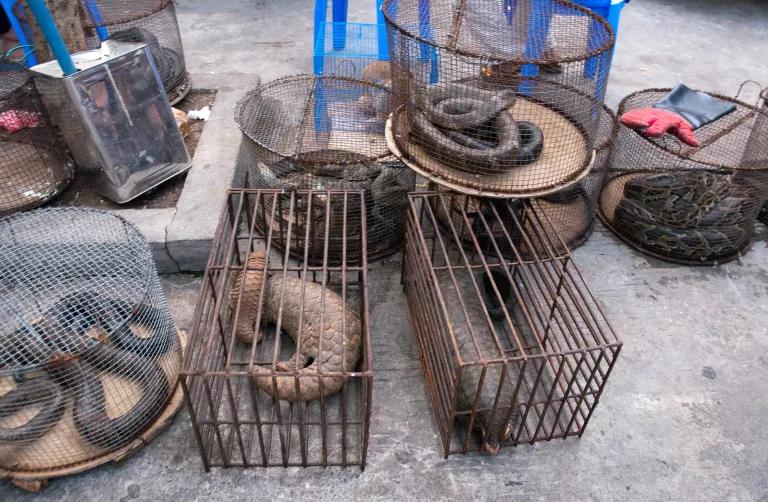
Pangolins, snakes, and monitor lizards at an illegal wildlife restaurant in Mong La, in Myanmar’s Shan State
Soggydan Benenovitch
International treaties, like the Convention on International Trade in Endangered Species, regulate the sale of tens of thousands of species but are not yet strict enough to protect the most vulnerable. These treaties often fail to address the underlying drivers of wildlife trade, such as a lack of alternative economic opportunities.
Climate Change
In the same way the climate crisis poses an existential threat to humanity, wildlife, too, will have to cope with prolonged droughts, more frequent wildfires, intensifying heat waves and storms, increased prevalence of infectious diseases, and food shortages. As the climate rapidly changes, wildlife will be forced to either shift their historic ranges, adapt to new stressors—or face extinction.
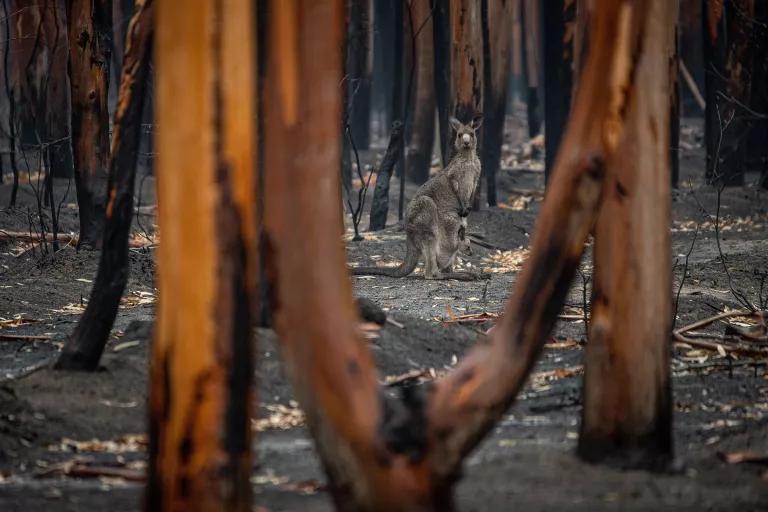
A kangaroo and her joey stand among burned out trees after wildfires swept through a forest in Mallacoota, Australia.
Jo-Anne McArthur
The primary drivers of climate change—the burning of fossil fuels and unsustainable agricultural production—are therefore primary threats to biodiversity too. The destruction of nature also creates a feedback loop: Healthy wetlands and old-growth forests, for instance, are responsible for absorbing nearly 50 percent of all carbon dioxide from human emissions. Their destruction represents a loss of this vital service.
“The biodiversity and climate crises are inextricably linked,” Smith says. “Not only are they often caused by the same destructive profit-driven activities, but they, thankfully, can be addressed with similar solutions—all of which require us to shift our relationship to the natural world.”
Pollution and Toxic Chemicals
Pollution is another major driver of declining biodiversity. According to the 2019 IPBES report, 300 to 400 million tons of industrial waste (heavy metals, solvents, toxic sludge, and other wastes) are dumped annually into the world’s waters; plastic pollution has increased tenfold since 1980; and agricultural runoff (which can include manure, pesticides, and fertilizers) washing into coastal ecosystems has produced at least 400 dead zones across the world’s oceans.
Some widely used agricultural chemicals can wreak havoc on ecosystems. For instance, the widespread use of the herbicide glyphosate, commonly known as Roundup, has decimated milkweeds. This, in turn, has led to dramatic declines in the iconic monarch, since it’s the only plant on which the butterfly lays its eggs. Neonicotinoids (or neonics), a neurotoxic insecticide—pesticides that kill insects by ultimately destroying their nerve cells—have also been linked to a dramatic decline in insects, as well as concerns for human health. “Unlike older, conventional insecticides, neonics are designed to be absorbed by plant tissues in order to make the plant itself toxic,” explains Raichel. “Today, neonics are the most widely used insecticides in the United States, contaminating soil and water and building up in areas of year-after-year use. As insect populations plummet, entire ecosystems are disrupted, harming birds, fish, and other wildlife.” While many countries have taken steps to ban neonics, protections in the United States have so far stalled.
Biodiversity Conservation
Thankfully, many positive models already exist for protecting and restoring ecosystems. Biodiversity can recover. Conservation initiatives that follow the leadership of Indigenous peoples—by prioritizing their sovereignty and learning from land management practices that, in some cases, have been finetuned over millennia—often succeed at preserving ecosystem health. In fact, Indigenous territories currently make up about 22 percent of the world’s land surface but hold 80 percent of the world’s remaining biodiversity. Biodiversity loss has been shown to occur more slowly in areas managed by Indigenous communities—communities that remain at the forefront of movements to halt environmentally destructive projects and strengthen land protections. And their efforts are paying off. In recent years, Indigenous leaders have successfully helped block the Keystone XL pipeline, the looming Pebble Mine in Alaska, and fossil fuel extraction in the sacred Bears Ears and Grand Staircase-Escalante National Monuments.
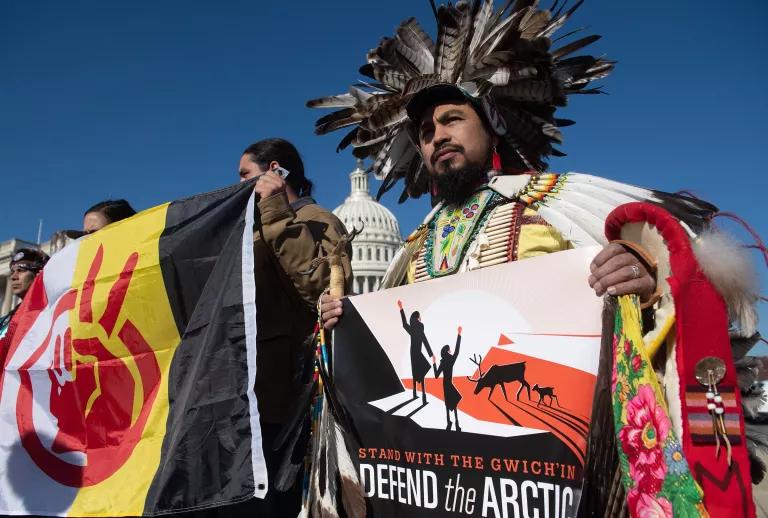
Indigenous activists speak out against drilling in the Arctic National Wildlife Refuge during a press conference outside the U.S. Capitol in Washington, D.C., on ANWR's 58th anniversary, on December 11, 2018.
Saul Loeb/AFP via Getty Images
While ecosystem restoration, or in situ conservation, should be prioritized, it can be supplemented by what’s known as ex situ conservation, which involves the breeding of endangered species in artificial ecosystems. This type of intervention should be reserved for species on the brink. In the Florida Keys, for example, scientists are trying to restore decimated coral reefs by growing hundreds of thousands of individual coral fragments in nurseries and then moving those corals out onto the reef.
Support Biodiversity Conservation
Biologist E.O. Wilson famously warned, “We’re extinguishing earth’s biodiversity as though the species of the natural world are no better than weeds and kitchen vermin.” The last few decades have been witness to heartbreaking declines in plant and animal life. But the roots of this crisis go back centuries, entwined with unsustainable ocean and land use driven by inequities in society—economic development founded on exploitation of all kinds. This shows up today as climate change and pollution disproportionately impact those, human and nonhuman, that contributed least to the problems.
To end the biodiversity crisis, we need to forge a radically new relationship with nature. “We need acts of restoration, not only for polluted waters and degraded lands but also for our relationship to the world,” writes Robin Wall Kimmerer, plant ecologist and enrolled member of the Citizen Potawatomi Nation. “We need to restore honor to the way we live, so that when we walk through the world, we don’t have to avert our eyes with shame; so that we can hold our heads up high and receive the respectful acknowledgment of the rest of the earth’s beings.”
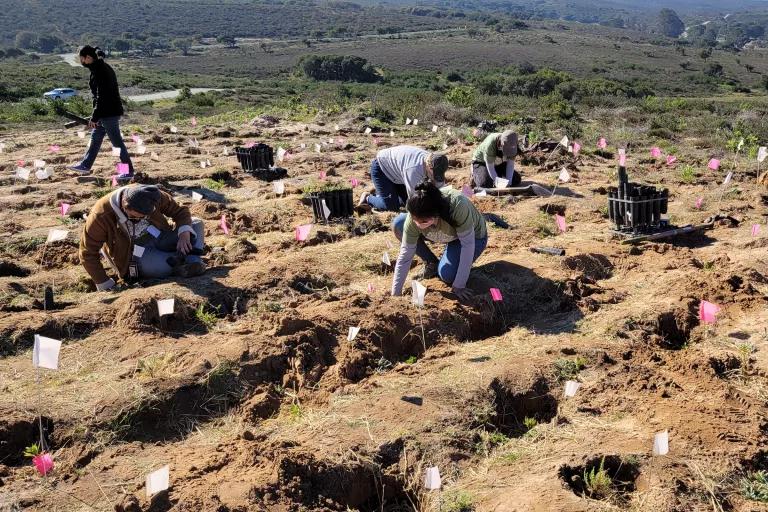
Since 1996, Fort Ord National Monument has partnered with California State University, Monterey Bay, on a project called Return of the Natives, where seedlings cultivated from local native plant seeds are returned to areas surrounding the monument that have been damaged due to erosion or human activities.
Bureau of Land Management
Restoring biodiversity requires long-lasting changes at all levels of society. As individual consumers, we cannot solve habitat destruction. But we can join networks of neighbors that borrow and share, and we can support a move toward a circular economy in which corporations establish less environmentally destructive—or even beneficial—life cycles for their products. Likewise, we cannot solve the biodiversity crisis by planting one tree. But we can join together to restore and conserve lands and waters, eventually connecting them with a goal like the Wilson Biodiversity Foundation’s Half Earth Project, which calls on people to dedicate half the planet to nature to ensure thriving biodiversity for future generations.
Solutions exist. Together, we can take action—in our own lives and in the global community—to restore biodiversity.
What are some things you can do right now?
- Learn more about where you live to grow your sense of place. What plants and animals can be found here? Where does your water come from? Who lived here before you? Ask yourself questions too: What do you want to leave behind for future generations?
- Find people who share your values and get involved with projects in your hometown, especially those that fight habitat loss by protecting ecosystems and reconnecting wild areas that have been fragmented.
- Not sure where to start? Marine biologist Ayana Elizabeth Johnson recommends simple tools like a Venn diagram to see how your skills can help solve big challenges.
- Start small: Plant native species gardens that support pollinators.
- Go further: Support leaders who recognize and act on the urgency of the biodiversity crisis.
What are some actions our government leaders can take?
- Support the Endangered Species Act (ESA), the most effective federal conservation law in the United States that protects at-risk wildlife and their habitat. Since its passage in 1970, the ESA has saved 99 percent of listed species from going extinct, but the law continues to be under attack from polluters and industry-funded politicians.
- Strengthen foundational laws like the Clean Air Act and Clean Water Act so that they can protect human health and the environment from modern threats.
- Stop accepting campaign donations from polluting and destructive industries—and end their heavy influence on the laws meant to regulate their impacts.
- Promote sustainable fisheries management to restore depleted stocks and ban destructive industrial fishing practices.
- Support the creation and protection of national parks, monuments, and wildlife sanctuaries, which are designed to help biodiversity thrive.
- Advocate for Indigenous sovereignty and center Indigenous leadership within the conservation movement.
- Invest in regenerative agriculture practices so all ranchers and farmers can work holistically with their environment.
- Ban all unnecessary uses of toxic pesticides—and better protect pollinators.
- Bar companies from producing or selling single-use paper products made from primary forests, which will reduce the pressure on forests, which are critical as carbon sinks and as protection for biodiversity.
What does the world need to do?
- Address the climate and biodiversity crises in tandem. Push for effective climate policies that prioritize the rapid end to fossil fuel extraction and consumption and a just transition to a clean energy economy.
- Advocate for full protection of at least 30 percent of our lands, rivers, lakes, wetlands, and oceans by 2030. This initiative, known as 30x30, is now backed by hundreds of scientists, NGOs, and governmental bodies. It represents a critical marker toward the goal of protecting 50 percent of nature by 2050.
- Commit to stopping species extinctions and putting all threatened species on a path to recovery by 2030.
- Eliminate wildlife exploitation, use, and trade that is ecologically unsustainable, illegal, or poses a risk of zoonotic disease transfer to humans, domestic animals, or other wildlife.
Taken together, these actions mean transformative change—from how we grow our food to how we design our cities. “We’re talking about fundamentally re-examining our relationship to nature and seeing its survival as necessary to our own,” Smith says. “The good news is that the same solutions that safeguard biodiversity also ward off climate change, improve our health, and build a more equitable society. Now, our leaders need to summon the courage to act, and if they don’t, we should vote them out for better leaders.”
This NRDC.org story is available for online republication by news media outlets or nonprofits under these conditions: The writer(s) must be credited with a byline; you must note prominently that the story was originally published by NRDC.org and link to the original; the story cannot be edited (beyond simple things such as grammar); you can’t resell the story in any form or grant republishing rights to other outlets; you can’t republish our material wholesale or automatically—you need to select stories individually; you can’t republish the photos or graphics on our site without specific permission; you should drop us a note to let us know when you’ve used one of our stories.


How to Become a Community Scientist
A World Without Bees? Here’s What Happens If Bees Go Extinct
24 Green Projects to Tackle Now